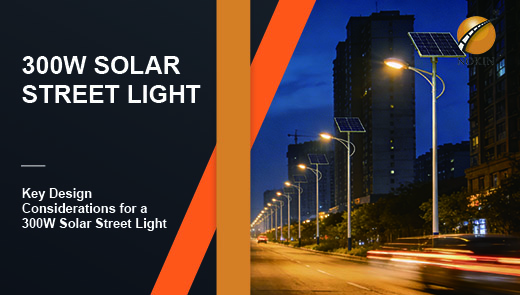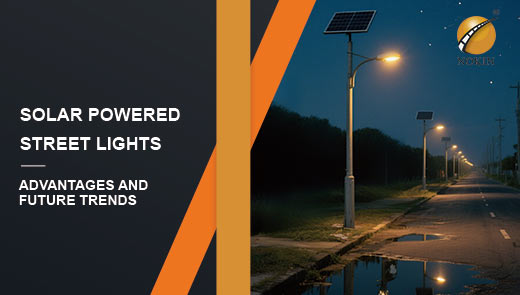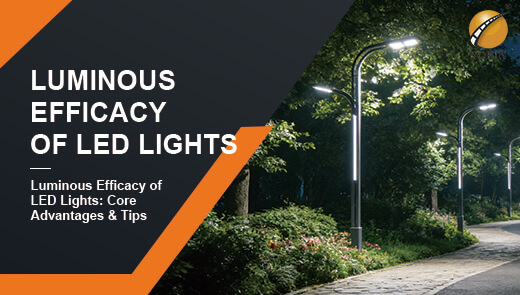Solar Street Light Poles: Types, Applications & How to Choose
In today's world where clean energy is gaining significant attention, solar street lights have rapidly emerged in the lighting industry due to their environmentally friendly and energy-saving characteristics. As the core structural component of the entire system, the performance of solar street light poles directly impacts the stability and lifespan of the lighting system. In the following sections, we will delve into the types of solar street light poles, their application scenarios, and how to make a scientifically sound and reasonable selection.
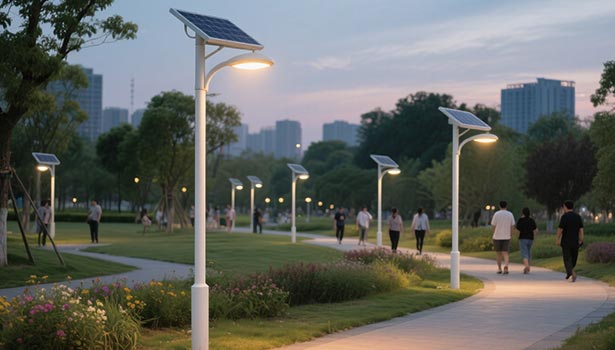
What are solar light poles and why do they matter?
Solar street light poles are not merely simple tubes supporting lighting fixtures; they are the “backbone” of the entire solar street light system. From a structural and functional perspective, they must securely support solar panels and LED lighting fixtures, and in many cases, also accommodate battery boxes.
If the pole is too short, has an insufficient diameter, or is made of inappropriate materials, even with high-performance solar panels, the system is highly prone to failure under environmental stresses such as strong winds, corrosion, and vibrations. For example, in coastal areas with strong winds, an unstable pole may be snapped by gusts; in high-humidity environments, materials with poor corrosion resistance may accelerate aging. Therefore, the selection of street light poles must comprehensively consider the total system weight, local wind conditions, and specific lighting application requirements, including solar panel size, installation angle, battery location, and even local theft risks. Only by precisely matching all parameters can the long-term stable operation of the solar street light system be ensured, achieving the goal of efficient and energy-saving lighting.
What are the different types of solar street light poles?
Solar street light poles can be categorized into various types based on design and material differences, with different types suited for different application scenarios.
Single-arm street light poles vs. Double-arm poles
The lamp arm of a street light pole is a critical structural component of a solar street light, extending outward from the top of the vertically installed pole to secure the lighting module and provide illumination coverage for the area below.
Single-arm street light poles: As the name suggests, single-arm street light poles can only mount one LED lighting module. In practical applications, they are commonly installed on one side of single or double lanes, suitable for scenarios with limited road width and relatively simple lighting requirements.
Double-arm street light poles: Double-arm street light poles can accommodate two lighting modules simultaneously. They are typically installed in the center of two-lane roads to provide symmetrical lighting for both sides of the road, offering significant advantages on wider roads or sections with high requirements for lighting uniformity.
Split street light poles vs. Unified poles
In the currently popular integrated solar street lights, the LED lighting fixtures, solar panels, and batteries are integrated into a single module, with the lamp arm supporting all components of the lighting fixture. This highly integrated design simplifies the installation process, reduces system complexity, and enhances overall aesthetics, making it suitable for scenarios with high requirements for installation efficiency and appearance, such as urban main roads and commercial districts.
In contrast, early split-type solar street lights featured independent lighting modules and solar panels. Split-type street light poles use a split-arm structure, placing the solar panels at the top of the pole; or, using accessories, suspending the solar panels on one side of the pole. While this design is slightly more complex to install, it offers greater flexibility in component maintenance and upgrades, allowing for the replacement of solar panels or lighting fixtures individually as needed. This design is commonly used in projects with strong cost control and customization requirements.
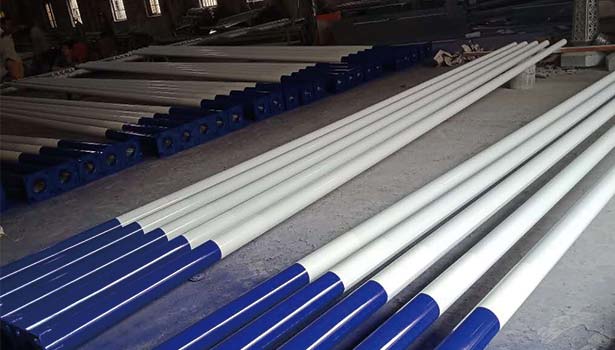
Steel solar street light poles vs. Aluminum poles
Currently, concrete-made street light poles are relatively rare, with steel and aluminum being the mainstream materials for street light poles in the market. These two materials differ in multiple performance parameters, as detailed in the table below:
|
Performance Indicator |
Steel Light Poles |
Aluminum Light Poles |
|
Stiffness |
High stiffness and structural stability; suitable for windy areas |
Relatively lower stiffness; requires optimized design for specific installations |
|
Strength-to-Weight Ratio |
Heavier for the same strength; slightly higher transport and installation costs |
Lightweight; easier to transport and install |
|
Corrosion Resistance |
Requires galvanization or anti-corrosion treatment; low maintenance cost |
Naturally corrosion-resistant; ideal for humid environments |
|
Maximum Height |
Can be made over 20 meters; suitable for large-scale areas |
Typically up to 15 meters; better for medium to low-height lighting |
|
Processing Difficulty |
Mature welding and cutting techniques but requires heavy equipment |
Highly formable and efficient to process; good for custom production |
|
Initial Cost |
Lower material cost; suitable for budget-conscious projects |
Higher material and processing cost; better long-term value |
The selection of materials for street light poles is directly or indirectly influenced by various factors such as the installation environment, climatic conditions, project budget, and lighting requirements.
C&I light poles vs. Residential street light poles
After decades of development, the application of solar street lights has expanded beyond the transportation sector. Today, custom-designed street lights for commercial and residential settings can be found along industrial park roads and around garden fences. Commercial settings have high foot and vehicle traffic and require longer lighting hours, so C&I light poles need to have stronger load-bearing capacity and stability, with generally greater height and more robust materials.
Residential settings prioritize a warm atmosphere and safety, so residential street light poles are typically shorter in design, with materials leaning toward aesthetic appeal and lightweight construction. While meeting lighting needs, they avoid light pollution and enhance living comfort. Different usage scenarios impose specific performance requirements on street light poles, thereby giving rise to corresponding pole types.
Functional street light poles vs. Decorative light poles
Modern urban transportation systems have become an important window for showcasing a city's image. Therefore, in addition to their basic functions of supporting and securing lighting components, there are now higher demands on the aesthetic appeal of lighting facilities. As the foundational components of street lighting, street light poles now also serve the function of promoting urban imagery. Many street lighting projects customize the theme colors, patterns, or elements of street light poles based on the city's visual identity system (VI), enabling them to contribute to urban energy transition and green development while achieving promotional value.
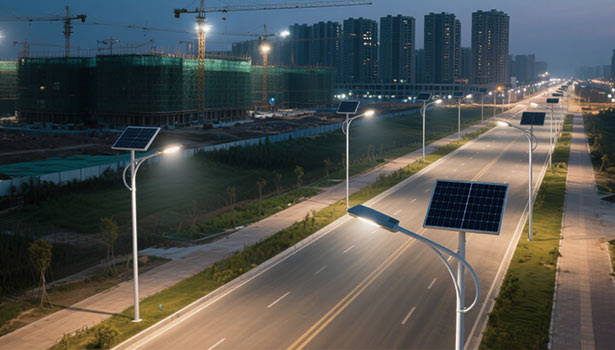
Height selection for street light poles in different application scenarios
The selection of street light pole height must comprehensively consider the type of lighting area, lighting intensity and coverage requirements, as well as aesthetic factors. The following are reference standards for street light pole heights in different scenarios:
Residential pathways and gardens
When used for lighting residential gardens, pathways, or driveways, street light pole heights typically range from 0.9 to 2.1 meters (3 to 7 feet). This height design allows the light to scatter downward in a soft manner, precisely illuminating walking paths while effectively controlling the lighting range to avoid direct light from shining into residents' windows, thereby reducing interference with daily life and creating a comfortable home environment.
Street lighting and parking lots
In open areas such as streets and parking lots, where safety and visibility are critical, street light pole heights generally range from 3.7 to 9.1 meters (12 to 30 feet). The specific height must be determined based on factors such as pole spacing, lighting technology type, and the width of the area to be illuminated.
Commercial outdoor areas
For outdoor seating areas, walkways, or entrances in commercial spaces, street light pole heights are typically between 3 and 6 meters (10 and 20 feet). This height ensures adequate lighting while also helping to create a warm and inviting commercial atmosphere.
Security lighting
When security is the primary purpose, the height of street light poles can vary significantly depending on the specific needs of the area. To achieve wide coverage, pole heights can reach 6–9 meters (20–30 feet), using wide-angle lighting to eliminate monitoring blind spots and make potential security risks visible. Additionally, taller poles can deter criminals and enhance the sense of security in the area.
Sports and recreational fields
For sports venues or large recreational areas, street light pole heights are typically higher, ranging from 12 to 30 meters (40 to 100 feet) or even higher. Only at such heights can light be evenly distributed across the ground, avoiding shadows caused by insufficient height that could impair athletes' performance and spectators' viewing experience, thereby ensuring the smooth conduct of various activities.

What to consider when choosing street light poles for your project?
When purchasing solar street lights, most buyers tend to focus on the performance of the electronic modules. However, the choice of street light poles is equally important, as it directly affects the cost-effectiveness and service life of the project. The following are key factors to consider when selecting ideal street light poles:
Installation environment
Solar street lights have a wide range of applications, including highways, urban roads, rural areas, and even desert regions. Environmental parameters such as temperature, humidity, wind speed, and soil composition vary significantly across different installation locations, posing distinct challenges to the physical and chemical properties of street light poles. For example, in tropical regions with year-round high temperatures and humidity, and occasional typhoon impacts, galvanized steel street light poles with excellent wind resistance and corrosion resistance are an ideal choice.
Illumination requirements
One aspect that many buyers often overlook is that the lighting performance of street lights is closely related to the configuration of the street light poles. Project developers or contractors can utilize modern lighting design software, combined with parameters provided by street light pole manufacturers, to simulate the lighting effects of street lights in actual installation sites. This enables precise selection of suitable street light pole types, ensuring project lighting requirements are met while avoiding resource waste and enhancing investment returns.
Aesthetics
As mentioned earlier, the evolution of lighting facility functionality has driven the development of solar street lights in terms of aesthetics. Project teams must clearly define the project's positioning. If the project combines lighting and promotional functions, cross-departmental communication and collaboration must be strengthened, with proper design and budget planning to ensure that the street light poles meet lighting requirements while showcasing the city's unique characteristics.
Budget and maintenance costs
When purchasing solar street lights, both short-term and long-term operational costs must be fully considered. Although solar street lights can operate independently of traditional power grids by integrating sensors and control devices, the overall costs—including initial investments and ongoing operations—can vary significantly depending on the type of street light pole selected. Some street light poles have lower initial procurement costs but may incur high maintenance expenses later on. Improperly configured street light poles may also lead to unnecessary investments and additional maintenance costs for other lighting components.
Solar street light poles come in various types, each with its unique application scenarios and suitability conditions. In actual projects, we must comprehensively consider factors such as pole type, installation environment, height requirements, lighting needs, aesthetics, budget, and maintenance costs to make a scientifically reasonable selection. Only by doing so can we create an efficient, durable, and aesthetically pleasing solar street light system that contributes to the lighting infrastructure of both urban and rural areas.

